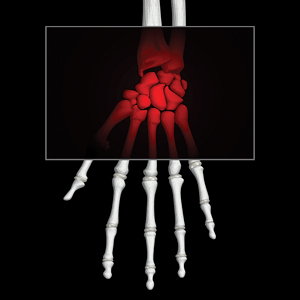It’s a painful hand and arm condition and one of the most common problems faced today, but fortunately carpal tunnel syndrome can be treated. The name describes it perfectly. The carpal bones are the small wrist bones; the tunnel is formed by the carpal ligament, which stretches across them. This tunnel is a narrow passageway that protects a main nerve to your hand and nine tendons that bend your fingers. Compression of the nerve produces the numbness, pain and, eventually, hand weakness that characterize carpal tunnel syndrome.
Most of us have heard that repetitive motion such as keyboarding, playing an instrument, cake decorating, video-gaming or anything that causes the wrist to flex and extend frequently, can contribute to carpal tunnel syndrome. There are many other causes, however, including pregnancy, thyroid disease, diabetes, and alcoholism.Carpal tunnel can also be caused by trauma, arthritis, or anything that causes the carpal tunnel to narrow.
The strong carpal ligament holds the wrist bones in a gentle arch, forming a D-shaped tunnel. Several structures pass through the tunnel from the forearm to the hand, including all the flexor tendons to the fingers and thumb. The structure most affected in carpal tunnel syndrome is the median nerve. This large nerve is very important to proper functioning of your hand, and compression of the nerve causes the symptoms we know as carpal tunnel syndrome.
The median nerve supplies sensation to your thumb, index, third finger, and part of the fourth finger, and controls movement of the muscles at the base of your thumb.Narrowing of the tunnel from swelling, fluid balance changes, arthritis, or anything else which causes compression of the median nerve, can result in numbness and tingling, pain, or a burning sensation in the hand and forearm and a weak thumb.
The symptoms may vary from day to day and they may get worse at night, even Awakening you from sleep. They may also worsen with activity, with a sensation that your hand is very swollen, even though it isn’t.
Diagnosis is fairly straightforward in many cases. Tapping the skin over the wrist crease may cause electric-shock-like feelings in the hand. Deep flexion of the wrist, bending it inward so that your fingers are closer to your forearm, will usually result in symptoms Within one minute. There may be tenderness at the forearm above the wrist and in the wrist itself, and there may be a small amount of swelling in the same area.
Sometimes other tests are performed to confirm the diagnosis or degree of compression. Electrodiagnostic tests are used if another problem, such as a pinched nerve in the neck, is suspected. Cortisone injections may be used as well; this calms down the inflammation and swelling and helps the physician confirm the diagnosis. Wrist x-rays are sometimes done to rule out arthritis or trauma.
The first-line treatment for carpal tunnel syndrome is wearing a simple splint at night for several weeks or, if that doesn’t help, during the day as well. There are special Aids available which help support your wrists when you are typing; your physician may refer you for occupational therapy to help develop better biomechanics. NSAIDs (non-steroidal anti-inflammatory drugs like ibuprofen or naproxen) may help as well.
Many cases of carpal tunnel syndrome can be relieved without surgery, but sometimes the symptoms will not respond to conservative therapy and surgery is needed.The surgery is done on an outpatient basis, and is a relatively short procedure.
Called carpal tunnel release, the surgery does just what it sounds like: It releases the ligament to relax the pressure on the median nerve. A small incision is made in the wrist, and the ligament is cut. If there is excess scar tissue in the tunnel, that may be removed as well. The release can be done either through a small open incision or endoscopically, using tiny instruments and lighted scopes inserted under the skin. Either way, it is usually a very successful procedure.
With any surgery, however, there is always a small risk of complications like bleeding or infection, although these are very rare, occurring in less than half of a percent of surgeries. After surgery, you will go through hand physical therapy to ensure good scar modeling and healing, and to help you learn proper techniques for keeping your wrist pain-free.
Patients should expect good results from surgery. If symptoms have been present for a long time, there may be some residual tingling or numbness, but it will certainly be better than before surgery. Most of the time, symptoms are completely resolved.




